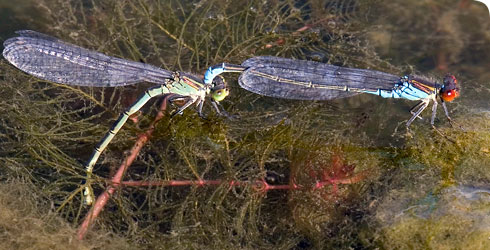Biology
In England, adults of the species are on the wing between July and mid-September and can be seen flying close to the water surface or perched on plants emerging from the water.
Reproduction
The males remain attached to the female during egg-laying, using claspers at the tip of his abdomen to grasp the female’s neck.
This prevents other males mating with the female. It also allows the male to pull the female clear of the water if threatened by potential predators such as fish or frogs.
The eggs are laid on the stems of aquatic plants growing near the water surface and usually hatch within a few days The eggs usually hatch within a few days of being laid.
Larvae
The larvae live amongst dense clumps of submerged aquatic plants, especially hornworts (Ceratophylum sp), where they hunt small aquatic animals such as waterfleas and insect larvae.
The larvae of both E. najas and E. viridulum have characteristic coarse hairs on the underside of the abdomen that distinguish them from other British damselflies.The leaf-like caudal lamellae at the tip of the abdomen are marked with dark blotches in E. viridulum whereas the caudal lamellae of E. najas larvae are marked with conspicuous dark bands.
